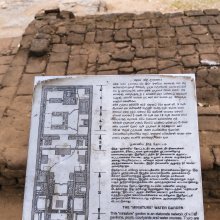Jalakrida, Jalakrīḍā, Jala-krida: 12 definitions
Introduction:
Jalakrida means something in Hinduism, Sanskrit, the history of ancient India, Marathi. If you want to know the exact meaning, history, etymology or English translation of this term then check out the descriptions on this page. Add your comment or reference to a book if you want to contribute to this summary article.
Images (photo gallery)
In Hinduism
Pancaratra (worship of Nārāyaṇa)
Source: archive.org: Catalogue of Pancaratra Agama TextsJalakrīḍa (जलक्रीड) or Jalakrīḍotsava is the name of a festival, as discussed in the twelfth chapter of the Īśvarasaṃhitā (printed edition), a Pāñcarātra work in 8200 verses and 24 chapters dealing with topics such as routines of temple worship, major and minor festivals, temple-building and initiation.—Description of the chapter [pakṣotsava-vidhi]: [...] The remainder of the chapter is devoted to describing in more detail some of these, and other, festivals; dvādaśī is described (11-24a); madhumāsotsava (=vasantotsava) which does not appear in the above list is also described, with some options given concerning its celebration (24b-40); jalakrīḍa-utsava, which is part of the foregoing, and is also not mentioned in the opening ślokas, is described (41-60); ācāryabahumāna is briefly treated (61-62); and damanikotsava is covered in somewhat more detail (63-92). The following are also described: viśākhotsava (93-Iroa); plavotsava (110b-143a); āgrayaṇotsava (143b-160); ḍolotsava (161-205a); and svāpotsava (205b-234a).

Pancaratra (पाञ्चरात्र, pāñcarātra) represents a tradition of Hinduism where Narayana is revered and worshipped. Closeley related to Vaishnavism, the Pancaratra literature includes various Agamas and tantras incorporating many Vaishnava philosophies.
India history and geography
Source: Cologne Digital Sanskrit Dictionaries: Indian Epigraphical GlossaryJala-krīḍā.—(ASLV), water sports. Note: jala-krīḍā is defined in the “Indian epigraphical glossary” as it can be found on ancient inscriptions commonly written in Sanskrit, Prakrit or Dravidian languages.

The history of India traces the identification of countries, villages, towns and other regions of India, as well as mythology, zoology, royal dynasties, rulers, tribes, local festivities and traditions and regional languages. Ancient India enjoyed religious freedom and encourages the path of Dharma, a concept common to Buddhism, Hinduism, and Jainism.
Languages of India and abroad
Marathi-English dictionary
Source: DDSA: The Molesworth Marathi and English Dictionaryjalakrīḍā (जलक्रीडा).—f (S) Diversion on or in the water;--as boat-racing, bathing-gambols, a river-jaunt, or sea-excursion.
Source: DDSA: The Aryabhusan school dictionary, Marathi-Englishjalakriḍā (जलक्रिडा).—f Diversion on or in the water.
Marathi is an Indo-European language having over 70 million native speakers people in (predominantly) Maharashtra India. Marathi, like many other Indo-Aryan languages, evolved from early forms of Prakrit, which itself is a subset of Sanskrit, one of the most ancient languages of the world.
Sanskrit dictionary
Source: DDSA: The practical Sanskrit-English dictionaryJalakrīḍā (जलक्रीडा).—playing in water, splashing one another with water.
Jalakrīḍā is a Sanskrit compound consisting of the terms jala and krīḍā (क्रीडा).
Source: Cologne Digital Sanskrit Dictionaries: Shabda-Sagara Sanskrit-English DictionaryJalakrīḍā (जलक्रीडा).—f.
(-ḍā) Sporting or gamboling in water, bathing for pleasure or amusement. Splashing one another with water. E. jala, and krīḍā pastime, play.
Source: Cologne Digital Sanskrit Dictionaries: Benfey Sanskrit-English DictionaryJalakrīḍā (जलक्रीडा).—f. playing in the water, [Pañcatantra] 53, 1.
Jalakrīḍā is a Sanskrit compound consisting of the terms jala and krīḍā (क्रीडा).
Source: Cologne Digital Sanskrit Dictionaries: Monier-Williams Sanskrit-English DictionaryJalakrīḍā (जलक्रीडा):—[=jala-krīḍā] [from jala] f. = -keli, [Mahābhārata i, iii; Harivaṃśa 7120; Pañcatantra; Bhāgavata-purāṇa v.]
Source: Cologne Digital Sanskrit Dictionaries: Yates Sanskrit-English DictionaryJalakrīḍā (जलक्रीडा):—[jala-krīḍā] (ḍā) 1. f. Sporting or gamboling in water.
[Sanskrit to German]
Sanskrit, also spelled संस्कृतम् (saṃskṛtam), is an ancient language of India commonly seen as the grandmother of the Indo-European language family (even English!). Closely allied with Prakrit and Pali, Sanskrit is more exhaustive in both grammar and terms and has the most extensive collection of literature in the world, greatly surpassing its sister-languages Greek and Latin.
Nepali dictionary
Source: unoes: Nepali-English DictionaryJalakrīḍā (जलक्रीडा):—n. sporting/frolicking in water by young boys and girls; splashing one another; swimming;
Nepali is the primary language of the Nepalese people counting almost 20 million native speakers. The country of Nepal is situated in the Himalaya mountain range to the north of India.
See also (Relevant definitions)
Starts with: Jalakridotsava.
Query error!
Full-text: Calakkiritai, Toyakrida, Varivihara, Jalakeli, Shatara, Jalakridotsava, Antahpura, Krida, Mahotsavavidhi.
Relevant text
Search found 17 books and stories containing Jalakrida, Jala-krida, Jala-krīḍā, Jalakreedaa, Jalakrīḍā, Jalakriḍā; (plurals include: Jalakridas, kridas, krīḍās, Jalakreedaas, Jalakrīḍās, Jalakriḍās). You can also click to the full overview containing English textual excerpts. Below are direct links for the most relevant articles:
Chaitanya Bhagavata (by Bhumipati Dāsa)
Verse 1.12.169 < [Chapter 12 - The Lord’s Wandering Throughout Navadvīpa]
Verse 3.8.116 < [Chapter 8 - Mahāprabhu’s Water Sports in Narendra- sarovara]
Verse 3.8.142 < [Chapter 8 - Mahāprabhu’s Water Sports in Narendra- sarovara]
Bhajana-Rahasya (by Srila Bhaktivinoda Thakura Mahasaya)
Text 23 < [Chapter 4 - Caturtha-yāma-sādhana (Madhyāhna-kālīya-bhajana–ruci-bhajana)]
Text 22 < [Chapter 5 - Pañcama-yāma-sādhana (Aparāhna-kālīya-bhajana–kṛṣṇa-āsakti)]
Sahitya-kaumudi by Baladeva Vidyabhushana (by Gaurapada Dāsa)
Text 7.71 < [Chapter 7 - Literary Faults]
World Journal of Pharmaceutical Research
An ayurvedic review of etiopathogesis and management of atisara roga (diarrhoea) < [2022: Volume 11, October special issue 14]
Allergic rhinitis in ayurvedic perspectives < [2015: Volume 4, August issue 8]
Allergic rhinitis in ayurvedic perspectives- case study < [2020: Volume 9, April issue 4]
Śrī Kṛṣṇa Aṣṭottara-śata Nāmavaḷḷiḥ
Vastu-shastra (Introduction to Indian architecture) (by D. N. Shukla)
Chapter 3e - Dhārāgṛha and Dolāgṛha (or Rathadolā) < [Volume 4 - Palace Architecture]
